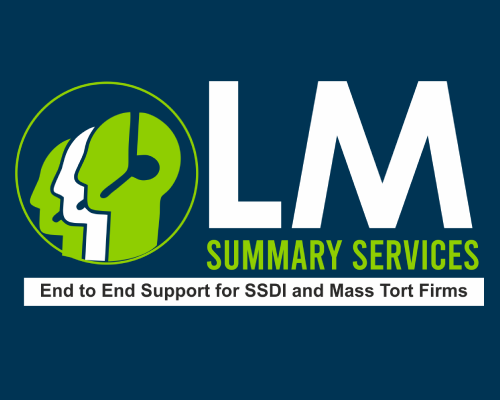Going through a Social Security Disability claims process is draining. Aside from confusing paperwork, applicants usually must deal with initial rejection. SSD applicants are looking for someone who cares and fights for their best interests. What better way to show you genuinely understand their situation and are successful in helping qualified disabled claimants get the benefits they deserve than with clients referring your firm or representation company?
Word-of-mouth truly impacts how people perceive your organization. However, to increase referrals - and consequently client acquisition - you must provide exceptional customer service before and throughout the long application process.
Having built up our SSD practice before shifting gears to assist other law firms, we’ve learned firsthand that referrals aren’t just valuable - they’re golden. But they don’t materialize out of thin air, you have to earn them. In this article, we’ll guide you through enhancing your client services to become genuinely referral-worthy.
The Importance of Referrals for SSD Law Firms

Firms and advocates know that securing Social Security Disability benefits can be stressful for clients. There are many obstacles on the long road and it is common for many applicants to be initially denied, requiring an appeals process. For many applicants, this time of uncertainty can lead to disillusionment and, in some cases, cause them to give up entirely.
However, this is an opportunity for lawyers and organizations to build supportive relationships with their clients. As a legal representative or advocate, you get to know your clients personally, learning details of their lives and the challenges they face. For many people, their legal team is more than just representation; they’re allies, confidants, and sometimes can become like family.
When a former client recommends your services, they're saying, “Yes, going through an SSD claim is hell, but with this team by my side, it was something I didn’t have to face alone.”
Strategies to Encourage Referrals From Clients

Build Trust
- Proactive communication: To make clients feel valued and reassured that their case is in good hands, you need proactive communication. This means giving regular updates on case progress and answering their questions promptly. You want clients to feel like their well-being and peace of mind are your priority.
- Personalize interactions: Every client has their story, needs, and worries. Making an effort to personalize your interactions with each client shows that you value them as people. Remembering personal details and showing empathy towards their circumstances can strengthen your bond, making clients more likely to refer your services to others.
- Emphasize value beyond monetary gain: Make it clear that your work isn’t just about winning cases - It's about positively impacting their lives. Highlight the broader implications of securing SSD benefits, such as financial stability and access to necessary medical care.
Make Referrals Easy and Rewarding
- Create a dedicated referral program: This involves outlining the benefits that referrers will receive, making sure these perks are attractive enough to motivate your clients to act. Equally important is simplifying the referral process itself. The easier you make it for a satisfied client to refer someone, the more likely it is they will do it.
- Use technology: There are plenty of online platforms for managing referrals, where submission and tracking progress is easy. Software like HelloReferrals has features that are ideal for attorneys. It automates much of the referral process, from submission to tracking and reward distribution.
- Show appreciation publicly: When clients go out of their way to recommend your services, acknowledging their efforts reinforces their decision to advocate for you. This could be through featuring their testimonials on your website, giving them a shout-out on social media, or sending personalized thank-you messages.
Get Organized
- Train staff on referral strategies: Everyone from the front desk to your paralegals should understand the mechanics of your referral program. Equip your team with the right skills and talking points to explain the benefits of referring friends and family to your firm.
- Track and measure results: Use the tools you have at your disposal — spreadsheets, CRM software, or specialized referral tracking platforms — to monitor how many referrals you’re getting, who’s referring the most, and how many turn into actual clients. This data lets you fine-tune your approach, reward top referrers, and identify areas for improvement.
- Stay compliant with ethical guidelines: Ensure every aspect of your referral program, from how you communicate it to the incentives you offer, complies with the rules set by the American Bar Association and your state’s bar association. It's about protecting your clients, your reputation, and the integrity of the legal profession.
Integrating Referrals into Your Client Acquisition Strategy

Client acquisition refers to the strategies and activities used to attract and convert prospects into clients who hire your services. These strategies combine various marketing efforts, including online advertising, community outreach, educational content, and referral programs.
You can grow your client base by making referrals a crucial part of your client acquisition strategy. Here are some practical steps to do this effectively:
- Make Referrals a Priority: Ensure your team understands the importance of referrals by including them in your business goals and performance metrics. This can help keep the focus on actively seeking referrals in every client interaction.
- Educate Your Clients: When clients choose your firm, let them know that referrals are a significant part of your practice and that you appreciate their help growing your community.
- Simplify the Referral Process: Make it possible for clients to easily refer others to you. Provide simple tools or links they can share and consider creating a dedicated page on your website explaining the referral process.
- Acknowledge and Reward Referrals: Recognize every referral, whether it results in a new client or not. A simple thank you note, a phone call, or an email can make your clients feel appreciated. For those referrals that convert into clients, consider sending a token of appreciation to the referrer.
- Monitor and Adjust: Track how referrals contribute to your client acquisition efforts. Use this data to understand what’s working well and where there might be room for improvement. This might mean adjusting how you ask for referrals, changing the rewards, or finding new ways to make referring easier for your clients.
- Incorporate Feedback: Listen to client feedback about the referral process. They might have valuable insights on how to make it more effective or user-friendly.
Using Social Media and Content Marketing
SSD law firms can foster a sense of community by sharing valuable content and engaging with their target audience on social media. Make content that people want to share, like blog posts, infographics, videos, and guides on SSD claims, understanding rights, and the newest changes in SSD law.
Interacting on social media sites like Facebook, LinkedIn, and Twitter can help this content reach more people, making it more visible and building a stronger connection with the audience. Taking it a step further, you can host live Q&A sessions on platforms such as Facebook Live or Instagram.
Continuous Improvement and Adaptation

You need feedback to improve and adapt your efforts. Let's take Jane as an example. Jane, a satisfied client of an SSD law firm, initially hesitated to refer others because she found the referral process time-consuming and was unsure how her friends would be treated. After being award her benefits, the firm sent her a follow-up survey about the referral process and other topics.
Jane suggested simplifying the referral process and communicating expectations to her referrals. Taking Jane’s feedback to heart, the firm restructured its referral program, making referrals as simple as clicking a button. They also began sending welcome messages to referred clients, outlining what they could expect and how they would be supported throughout the SSD claim process.
The firm didn’t stop there; they reached out to Jane to thank her for the helpful feedback and informed her about the changes made. They even included Jane’s story (with her permission) in their next newsletter, emphasizing how client feedback directly influences their practices to serve both current and prospective clients better.
This shows how listening and adapting to client feedback works. It enhanced the referral process and strengthened Jane’s trust and loyalty, making her more likely to refer. Continuously adapting and improving can turn casual clients into loyal advocates, improving your company’s reputation and ability to get new clients over time.
The Cycle of Satisfaction and Referral

Client satisfaction is the foundation of a successful referral system for your law practice. Clients who feel valued and supported will become your best advocates and tell others about their good experiences with you. For this to happen, you must continually review and improve your client relations practices.
One way to enhance your service is to invest in staff training so they’re more empathetic and responsive. Another way is to optimize processes so each client has a better experience. By focusing on making every client interaction outstanding, law firms can naturally encourage the flow of referrals.
However, improving your client service model and referral strategy is not always straightforward. This is where consulting with experts such as DL Marketing can help. We're experts at helping SSD law firms like yours improve how they serve clients and get referrals.





 Home
Home